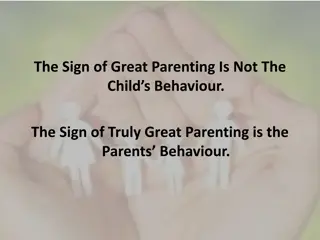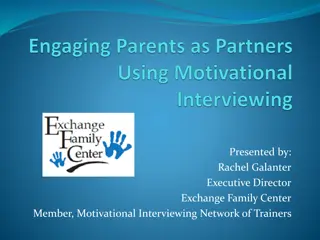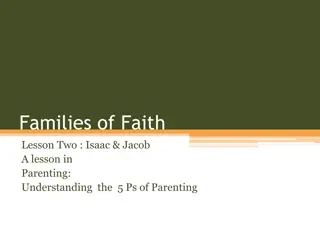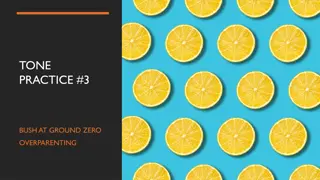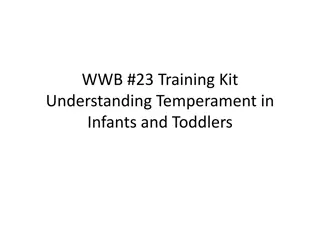Temperament in Parenting for Better Relationships
Utilizing a temperament approach in parenting can reduce conflicts by enhancing parent-child understanding. Temperament encompasses inborn traits influencing behavior, with three main styles - Easy going/Flexible, Quiet/Slow to warm, and Feisty/Spirited. Recognizing and adapting to a child's temperament can lead to effective parenting strategies focused on teaching and guidance, ultimately fostering harmonious relationships between parents and children.
Download Presentation

Please find below an Image/Link to download the presentation.
The content on the website is provided AS IS for your information and personal use only. It may not be sold, licensed, or shared on other websites without obtaining consent from the author.If you encounter any issues during the download, it is possible that the publisher has removed the file from their server.
You are allowed to download the files provided on this website for personal or commercial use, subject to the condition that they are used lawfully. All files are the property of their respective owners.
The content on the website is provided AS IS for your information and personal use only. It may not be sold, licensed, or shared on other websites without obtaining consent from the author.
E N D
Presentation Transcript
Parents who use a temperament approach to parenting reduce conflicts between themselves and their children due to the fact that: Parents who use a temperament approach to parenting reduce conflicts between themselves and their children due to the fact that: Parents know their children better than anyone else Many factors form personality Discipline is about teaching and guidance There is an approach for every child You are not instant experts when you become a parent Parents know their children better than anyone else Many factors form personality Discipline is about teaching and guidance There is an approach for every child You are not instant experts when you become a parent
What is temperament? Temperament assessment of self and child Parenting w/temperament in mind Ten temperament traits Strengths based in dealing w/temperament Out w/labels, in with descriptions Discipline or punishment? Prevent temperament problems Dealing w/problem behaviors What is temperament? Temperament assessment of self and child Parenting w/temperament in mind Ten temperament traits Strengths based in dealing w/temperament Out w/labels, in with descriptions Discipline or punishment? Prevent temperament problems Dealing w/problem behaviors Temperament Video
Temperament is neither good or bad It s an inborn trait Our basic temperament remains throughout life Temperament has a great deal to do with how we behave and with how others perceive us Temperament is neither good or bad It s an inborn trait Our basic temperament remains throughout life Temperament has a great deal to do with how we behave and with how others perceive us
Three main temperament styles Three main temperament styles Easy going/Flexible Easy going/Flexible Quiet/Slow to warm Quiet/Slow to warm Feisty/Spirited Feisty/Spirited
Temperament is a set of ten traits that explain the how of behavior Temperament is a set of ten traits that explain the how of behavior Type of Interactions Type of Interactions Effective Parenting Effective Parenting It is the parent s responsibility to modify their parenting approach It is the parent s responsibility to modify their parenting approach
Assess your own temperament Assess your own temperament Assess your children s temperaments Assess your children s temperaments Easiest combinations are mid Easiest combinations are mid- -range range Most volatile interactions are those w/ highs and lows on the same scale Most volatile interactions are those w/ highs and lows on the same scale
Activity Level Adaptability Approach/Withdrawal Distractibility Emotional Sensitivity Self Others Activity Level Adaptability Approach/Withdrawal Distractibility Emotional Sensitivity Self Others
Intensity Intensity Mood/ Mood/Soothability Soothability Persistence/Frustration Tolerance Persistence/Frustration Tolerance Regularity Regularity Sensory Awareness Sensory Awareness
How would you fill your leisure time? In activity or relaxation? Would you be on the go or idle? How about your child? How would you fill your leisure time? In activity or relaxation? Would you be on the go or idle? How about your child? Low Activity Calm and slow moving Low Activity Calm and slow moving High Activity wild and quick moving High Activity wild and quick moving
Heed the signals that indicate it's time for your child to blow off steam and find a way to let her do so. Incorporate some active time during the day. Walk to school instead of driving or stop at the park on the way to go grocery shopping. Avoid using confinement as a method of discipline.
Allow enough time for tasks and activities. Allow enough time for tasks and activities. Use a timer to set a goal for when a chore should be finished Use a timer to set a goal for when a chore should be finished Reward your child for sticking with a project and completing it in a timely fashion. Reward your child for sticking with a project and completing it in a timely fashion.
How easily a person adjusts to others How you are influenced by what others are doing or thinking Adapt quickly to changes, new places, ideas, expectations? Is it difficult or easy? How easily a person adjusts to others How you are influenced by what others are doing or thinking Adapt quickly to changes, new places, ideas, expectations? Is it difficult or easy? Fast adapting Easygoing Fast adapting Easygoing Slow adapting Strong willed Slow adapting Strong willed
Teach him to make his own decisions rather than just go along with his peer group. Teach him to make his own decisions rather than just go along with his peer group. Encourage her to find out all she can about an activity before signing up and committing her time. Encourage her to find out all she can about an activity before signing up and committing her time.
Give plenty of warning about transitions. Give plenty of warning about transitions. Role play or practice expected behaviors before going into new situations. Role play or practice expected behaviors before going into new situations. Acknowledge the stress she feels in new situations and encourage her to talk about it calmly. Acknowledge the stress she feels in new situations and encourage her to talk about it calmly.
Response to a new experience such as meeting a new person, tasting a new food,or in a new situations. Best Clue: What is the first and usual reaction? Response to a new experience such as meeting a new person, tasting a new food,or in a new situations. Best Clue: What is the first and usual reaction? Quick to approach Outgoing Quick to approach Outgoing Slow to approach Slow to warm up Slow to approach Slow to warm up
Provide firm rules and close supervision. This child is curious! Provide firm rules and close supervision. This child is curious! Teach him to use reasonable caution with new people or in new situations. Teach him to use reasonable caution with new people or in new situations.
Allow time to adjust to new situations; and let her set the pace. Allow time to adjust to new situations; and let her set the pace. Quietly encourage him, without pushing, to try new activities and make new friends. Quietly encourage him, without pushing, to try new activities and make new friends.
How easily your thoughts or attention is interrupted by things around you. How easily your thoughts or attention is interrupted by things around you. Best clue: Are you aware of or easily diverted by noises and people? Can you distract yourself from upset feelings by re your attention? Best clue: Are you aware of or easily diverted by noises and people? Can you distract yourself from upset feelings by re- -directing your attention? directing Low distractibility Not easily distracted Low distractibility Not easily distracted High distractibility Easily distracted High distractibility Easily distracted
Reduce external distractions as much as possible. Reduce external distractions as much as possible. Keep instructions short and clear. Keep instructions short and clear. Use a special cue to remind her to get back on task. Use a special cue - - gesture or word to remind her to get back on task. gesture or word - -
Cue him when it's time to move on to something new, e.g., say his name or touch his arm. Cue him when it's time to move on to something new, e.g., say his name or touch his arm. Set a timer to remind her when to move on to the next task or activity. Set a timer to remind her when to move on to the next task or activity.
Emotional response to situations, your own feelings and sensitivity to others Best clue: Do you often become upset over nothing or do you rarely become upset even when circumstances suggest that you should? Self Insensitive to own feelings Unaware of emotions Emotional response to situations, your own feelings and sensitivity to others Best clue: Do you often become upset over nothing or do you rarely become upset even when circumstances suggest that you should? Self Insensitive to own feelings Unaware of emotions Highly sensitive Feels own emotions strongly Highly sensitive Feels own emotions strongly Others Insensitive to other feelings Emotionally tuned out Others Insensitive to other feelings Emotionally tuned out Highly sensitive Emotional tuned in Highly sensitive Emotional tuned in
Acknowledge your child's feelings and provide ways for her to make herself more comfortable. Acknowledge your child's feelings and provide ways for her to make herself more comfortable. Layer clothes to allow for adjustments on days that are too warm or too cold. Layer clothes to allow for adjustments on days that are too warm or too cold. Avoid overstimulation, e.g., loud music, strobe lights, noisy groups of people Avoid overstimulation, e.g., loud music, strobe lights, noisy groups of people
Help him to notice external cues by pointing out odors or sounds in the environment and changes in the colors of stoplights. Help him to notice external cues by pointing out odors or sounds in the environment and changes in the colors of stoplights. Explain interpersonal cues, such as facial expressions, body language, and personal space. Explain interpersonal cues, such as facial expressions, body language, and personal space.
Energy put into expressing emotions Best clue: How physically dramatic, fierce, or passionate are you when expressing strong feelings? Do others find you easy or hard to read? Energy put into expressing emotions Best clue: How physically dramatic, fierce, or passionate are you when expressing strong feelings? Do others find you easy or hard to read? Low intensity Mild reactions Low intensity Mild reactions High intensity Dramatic reactions High intensity Dramatic reactions
Teach her to control her emotional responses through anger management, self Teach her to control her emotional responses through anger management, self- -talk, or calming strategies talk, or calming strategies Help prepare the child for transitions from one type of environment to another Help prepare the child for transitions from one type of environment to another Limit overly pulsating noises, flashing lights, etc. Limit overly- -stimulating situations: pulsating noises, flashing lights, etc. stimulating situations:
Don't equate a lack of intensity with lack of feelings. Don't equate a lack of intensity with lack of feelings. Watch and listen carefully to pick up more subtle clues to problems. Watch and listen carefully to pick up more subtle clues to problems.
The length of time a person will continue to make an effort, especially when tasks get hard. Best clue: Do you stick with things even when frustrated? Can you easily stop an activity when asked to? The length of time a person will continue to make an effort, especially when tasks get hard. Best clue: Do you stick with things even when frustrated? Can you easily stop an activity when asked to? High persistence Get locked in High persistence Get locked in Low persistence Stop easily Low persistence Stop easily
Provide lots of warning before transitions. Provide lots of warning before transitions. Remind him that it's not always possible to be perfect. Remind him that it's not always possible to be perfect. Help child prioritize tasks Help child prioritize tasks
Break tasks into small steps and acknowledge small successes. Break tasks into small steps and acknowledge small successes. Try timed work periods followed by short breaks. Try timed work periods followed by short breaks. Reward her for sustained effort and finished assignments Reward her for sustained effort and finished assignments
Amount of pleasant, friendly behavior as contrasted with unpleasant, unfriendly behavior Best clue: Is the usual first response to new ideas No! or Yes! Are you optimistic or pessimistic? Light Amount of pleasant, friendly behavior as contrasted with unpleasant, unfriendly behavior Best clue: Is the usual first response to new ideas No! or Yes! Are you optimistic or pessimistic? Light- -hearted or serious? hearted or serious? Positive mood Generally carefree Positive mood Generally carefree Negative mood Serious, displeased Negative mood Serious, displeased
Be sensitive to subtle signs of unhappiness that she may be bottling up inside. Be sensitive to subtle signs of unhappiness that she may be bottling up inside. Teach appropriate ways to express feelings of sadness, anger, fear, and frustration. Teach appropriate ways to express feelings of sadness, anger, fear, and frustration.
Try to ignore his general negative mood but tune in to real distress. Try to ignore his general negative mood but tune in to real distress. Encourage her to recognize and talk about the things that make her happy. Encourage her to recognize and talk about the things that make her happy. Act as a role model for positive social interactions. Act as a role model for positive social interactions.
Day to day predictability of hunger, sleep and elimination Best clue: Do you tend to go to bed, wake up, or want meals at the same time each day? Day to day predictability of hunger, sleep and elimination Best clue: Do you tend to go to bed, wake up, or want meals at the same time each day? Hunger Food at same time Hunger Food at same time Irregular eater Irregular eater Sleep Tired on schedule Sleep Tired on schedule No schedule No schedule
Provide advanced warning of changes in routine. Provide advanced warning of changes in routine. Help her learn to handle changes now to develop flexibility as she gets older. Help her learn to handle changes now to develop flexibility as she gets older.
Create routines, even if they seem odd. Ask him to sit down with the family for dinner even if he's not hungry or go to bed at a regular time even if he's not sleepy. Create routines, even if they seem odd. Ask him to sit down with the family for dinner even if he's not hungry or go to bed at a regular time even if he's not sleepy. Reward successes, such as turning in a project on time. Reward successes, such as turning in a project on time.
How sensitive are you to: pain, touch, taste, temperature, smells, hearing and sight. Best clue: How aware are you of noises, temperature changes, lights, odors, flavors, textures? How do you respond to pain? Pain what nail in my foot? How sensitive are you to: pain, touch, taste, temperature, smells, hearing and sight. Best clue: How aware are you of noises, temperature changes, lights, odors, flavors, textures? How do you respond to pain? Pain what nail in my foot? EEEEEEEOOOWWW EEEEEEEOOOWWW Light touch No reaction to contact Light touch No reaction to contact Easily irritated or pleased Easily irritated or pleased
Taste Can t tell the difference Taste Can t tell the difference Notice tiny variations Notice tiny variations Smell Don t notice odors Smell Don t notice odors Human bloodhound Human bloodhound Hearing/Sound Don t Hearing/Sound Don t notice notice noise noise Sensitive to sounds Sensitive to sounds Sight/Light Visually insensitve Sight/Light Visually insensitve Visually sensitive Visually sensitive
Acknowledge your child's feelings and provide ways for her to make herself more comfortable. Acknowledge your child's feelings and provide ways for her to make herself more comfortable. Layer clothes to allow for adjustments on days that are too warm or too cold. Layer clothes to allow for adjustments on days that are too warm or too cold. Avoid overstimulation, e.g., loud music, strobe lights, noisy groups of people. Avoid overstimulation, e.g., loud music, strobe lights, noisy groups of people.
Help his notice external cues by pointing out sounds in the environment, odors, and changes in the colors of stoplights. Help his notice external cues by pointing out sounds in the environment, odors, and changes in the colors of stoplights. Explain interpersonal cues, such as facial expressions, body language, personal space. Explain interpersonal cues, such as facial expressions, body language, personal space.
Characteristics include: Characteristics include: Easygoing during transitions Easygoing during transitions Predictable biological rhythms Predictable biological rhythms Not easily upset Not easily upset Generally has a positive mood Generally has a positive mood
Low intensity Low intensity Easily Easily soothable soothable Low distractibility Low distractibility Low sensitivity to sensory stimuli Low sensitivity to sensory stimuli
Characteristics include: Slow to adapt and react negatively to new environments, routines, activities Characteristics include: Slow to adapt and react negatively to new environments, routines, activities Relatively inactive and fussy Relatively inactive and fussy Not as irregular as feisty Not as irregular as feisty temperaments temperaments
Somewhat sensitive to sensory stimuli Somewhat sensitive to sensory stimuli Mild responses to emotional reaction Mild responses to emotional reaction Moderately negative mood, but once child is relaxed then mood improves Moderately negative mood, but once child is relaxed then mood improves Not persistent, but hesitant Not persistent, but hesitant
Characteristics include: Characteristics include: Slow to adapt to new routines Slow to adapt to new routines Irregular biological rhythms Irregular biological rhythms High sensitivity to sensory stimuli High sensitivity to sensory stimuli
High intensity in their reactions High intensity in their reactions Mood is often fussy and high strung Mood is often fussy and high strung High persistence High persistence Not easily distracted Not easily distracted
Easy going children: Even though the child is not demanding attention, parents are responsible for checking in often. These children are easily overlooked and ignored, and are at risk for negative influence. They need structure in their environment and daily routine to build a sense of security. Easy going children: Even though the child is not demanding attention, parents are responsible for checking in often. These children are easily overlooked and ignored, and are at risk for negative influence. They need structure in their environment and daily routine to build a sense of security.
Easy going children: Easy going children: Use positive reinforcement, state clear expectations, apply redirection, role model expected behavior, use natural and logical consequences Use positive reinforcement, state clear expectations, apply redirection, role model expected behavior, use natural and logical consequences Avoid going to extremes, yelling, power struggles and inconsistencies Avoid going to extremes, yelling, power struggles and inconsistencies Continue to provide opportunities for exploration of new activities and places, otherwise these children get bored. Continue to provide opportunities for exploration of new activities and places, otherwise these children get bored.
Implement ways to change the environment to fit your child s needs: Feisty children Create a structured environment, routined days, provide reminders for changes and expectations, ignore minor negative attention seeking behaviors, acknowledge positive behavior, provide consistent discipline and guidance Implement ways to change the environment to fit your child s needs: Feisty children Create a structured environment, routined days, provide reminders for changes and expectations, ignore minor negative attention seeking behaviors, acknowledge positive behavior, provide consistent discipline and guidance
Implement ways to change the environment to fit your child s needs: Feisty children Implement ways to change the environment to fit your child s needs: Feisty children Apply positive redirections, use no sparingly , give reasons, teach and model emotions, reduce stimulation, expect clear parent and child roles, offer physical expressions of support, give warnings Apply positive redirections, use no sparingly , give reasons, teach and model emotions, reduce stimulation, expect clear parent and child roles, offer physical expressions of support, give warnings





